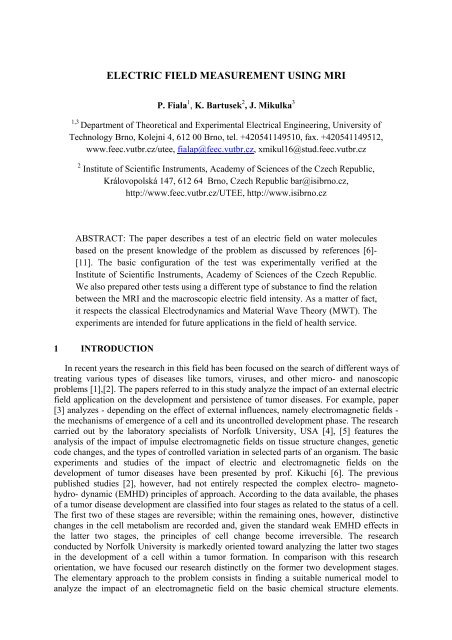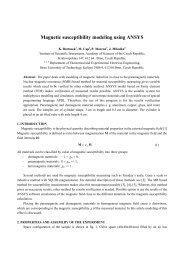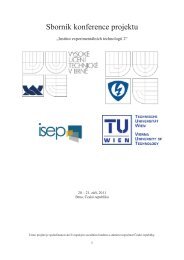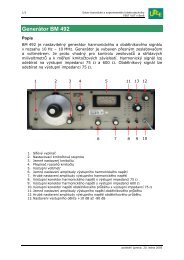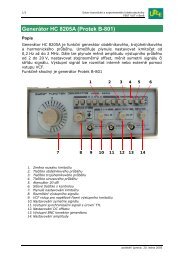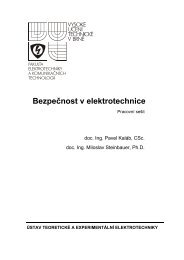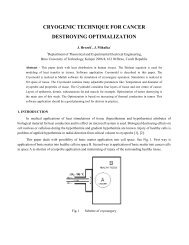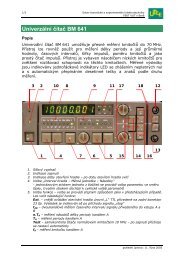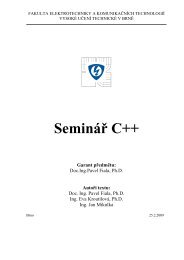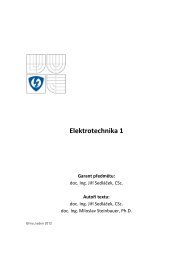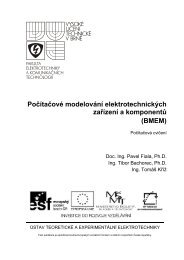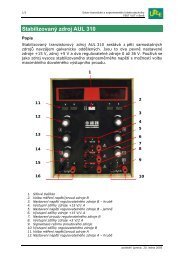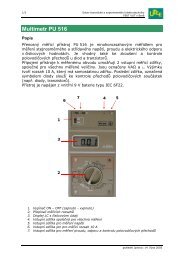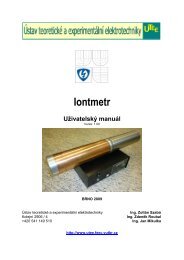ELECTRIC FIELD MEASUREMENT USING MRI - UTEE
ELECTRIC FIELD MEASUREMENT USING MRI - UTEE
ELECTRIC FIELD MEASUREMENT USING MRI - UTEE
You also want an ePaper? Increase the reach of your titles
YUMPU automatically turns print PDFs into web optimized ePapers that Google loves.
<strong>ELECTRIC</strong> <strong>FIELD</strong> <strong>MEASUREMENT</strong> <strong>USING</strong> <strong>MRI</strong><br />
P. Fiala 1 , K. Bartusek 2 , J. Mikulka 3<br />
1,3<br />
Department of Theoretical and Experimental Electrical Engineering, University of<br />
Technology Brno, Kolejni 4, 612 00 Brno, tel. +420541149510, fax. +420541149512,<br />
www.feec.vutbr.cz/utee, fialap@feec.vutbr.cz, xmikul16@stud.feec.vutbr.cz<br />
2 Institute of Scientific Instruments, Academy of Sciences of the Czech Republic,<br />
Královopolská 147, 612 64 Brno, Czech Republic bar@isibrno.cz,<br />
http://www.feec.vutbr.cz/<strong>UTEE</strong>, http://www.isibrno.cz<br />
ABSTRACT: The paper describes a test of an electric field on water molecules<br />
based on the present knowledge of the problem as discussed by references [6]-<br />
[11]. The basic configuration of the test was experimentally verified at the<br />
Institute of Scientific Instruments, Academy of Sciences of the Czech Republic.<br />
We also prepared other tests using a different type of substance to find the relation<br />
between the <strong>MRI</strong> and the macroscopic electric field intensity. As a matter of fact,<br />
it respects the classical Electrodynamics and Material Wave Theory (MWT). The<br />
experiments are intended for future applications in the field of health service.<br />
1 INTRODUCTION<br />
In recent years the research in this field has been focused on the search of different ways of<br />
treating various types of diseases like tumors, viruses, and other micro- and nanoscopic<br />
problems [1],[2]. The papers referred to in this study analyze the impact of an external electric<br />
field application on the development and persistence of tumor diseases. For example, paper<br />
[3] analyzes - depending on the effect of external influences, namely electromagnetic fields -<br />
the mechanisms of emergence of a cell and its uncontrolled development phase. The research<br />
carried out by the laboratory specialists of Norfolk University, USA [4], [5] features the<br />
analysis of the impact of impulse electromagnetic fields on tissue structure changes, genetic<br />
code changes, and the types of controlled variation in selected parts of an organism. The basic<br />
experiments and studies of the impact of electric and electromagnetic fields on the<br />
development of tumor diseases have been presented by prof. Kikuchi [6]. The previous<br />
published studies [2], however, had not entirely respected the complex electro- magnetohydro-<br />
dynamic (EMHD) principles of approach. According to the data available, the phases<br />
of a tumor disease development are classified into four stages as related to the status of a cell.<br />
The first two of these stages are reversible; within the remaining ones, however, distinctive<br />
changes in the cell metabolism are recorded and, given the standard weak EMHD effects in<br />
the latter two stages, the principles of cell change become irreversible. The research<br />
conducted by Norfolk University is markedly oriented toward analyzing the latter two stages<br />
in the development of a cell within a tumor formation. In comparison with this research<br />
orientation, we have focused our research distinctly on the former two development stages.<br />
The elementary approach to the problem consists in finding a suitable numerical model to<br />
analyze the impact of an electromagnetic field on the basic chemical structure elements.
Within the process of numerical analysis, we perform the testing of the impact of an electric<br />
field on a small volume of purified homogeneous H 2 O water. In this respect, the<br />
interdependence is sought between the impacts of size, direction, and instantaneous course of<br />
the electric field intensity on the molecular properties of the material (water). Further,<br />
experiments are performed using the Nuclear Magnetic Resonance (NMR) and the Magnetic<br />
Resonance Imaging (<strong>MRI</strong>), and the shift and variation of the spectral line of the examined<br />
sample are monitored. In the process of the verification of laws resulting from the MWT and<br />
the available plus verifiable theories [7]-[13], the procedure of an electric field impact<br />
analysis will be directed toward more complex organic structures. The elementary findings of<br />
the sample status in the NMR testing are further completed with numerical analysis [13].<br />
2 <strong>MRI</strong> EXPERIMENTS<br />
In order to set the NMR method, both the impacts thereof on the resulting image and the<br />
material in-homogeneity impact on the processing of the NMR image were examined and<br />
numerically modeled [15]. Further, to support the analysis of the impact of an electric field<br />
depending on the instantaneous value and size of electric field E intensity on the samples that<br />
can be located close to the operator, we developed special controlled voltage sources with<br />
output voltage regulation of U out =1-100kV and current limitation (to the value of current<br />
manageable by a human organism) within the range of I out 0-1mA. Figs. 1 and 2 show the<br />
conception of the controlled, high-voltage source. This problem is analyzed in greater detail<br />
by the [14] reference study.<br />
Fig.1 A High Voltage source compact conception - the model, the scheme and the experimental measurement<br />
This work deals with the design of an electronically controlled high-voltage power source<br />
used for special purposes. The source will be used to set up the intensity of an electric field on<br />
predefined shapes of material samples, from simple inorganic to complex organic materials.<br />
The design must fulfill the condition of a constant setting of the source's output current. The<br />
regulation ranges should be: output voltage U o =1-100kV, electric current I max =10µA-10mA,<br />
frequency f=0-1kHz. The device must satisfy safety requirements specified by Czech<br />
standards (ČN). Several designs have been prepared on the basis of available materials, and
one was selected and realized: a circuit with an offline fly-back regulator, regulated with<br />
pulse-width modulation frequency f m =30 kHz. The power source was realized and its<br />
specifications were experimentally verified. The electronic control wiring diagram of the<br />
high-voltage source with current limitation is shown in fig. 3. The numerical analysis results<br />
were experimentally verified using the 200 MHz/75 mm MR tomograph at the ISI, AS CR (fig. 9).<br />
The tomograph elementary magnetic field B 0 = 4,7000 T is generated by a superconducting horizontal<br />
magnet produced by the Magnex Scientific company. The resonance frequency for the cores 1 H is<br />
200 MHz. From the measurements performed using the <strong>MRI</strong> we obtained the results of the electric<br />
field intensity E impact on the cores of the H 2 O sample; an overview of these results is provided in<br />
tab. 1. Further, experiments were carried out on the H 2 O sample using a device with a system of<br />
electrodes. There was a distance of 20mm between the electrodes, which were fixed to a laboratory<br />
beaker containing the water sample. The fixation was realized in such a manner as to eliminate the<br />
displacement current effects on all the surfaces and dielectric volumes. Leakage current was secured,<br />
with the resulting assurance of operator safety. Then, the first measurement without the electric field<br />
intensity E impact on the examined sample showed the centre on the frequency of f 0 =184Hz. After<br />
connecting voltage to the electrodes and producing the electric field intensity of 50kV/m-4050kV/m,<br />
we managed repeatedly to measure the resonance line shift of ∆f = 4 Hz. Thus, the influence was<br />
experimentally proved of the electric field static intensity on the motion and behavior of water<br />
molecule cores. According to the well-known relation between the change of frequency and the<br />
change of magnetic induction [15], the change of magnetic induction is<br />
Fig.2 High Voltage source component conception and one module of the source<br />
Fig.3 High Voltage source diagram of electronic control
2π<br />
∆f<br />
2π<br />
∆f<br />
∆ B = = (1)<br />
8<br />
γ 2,6710<br />
where f [Hz] is the frequency, γ [T -1 .s -1 ] is the gyro-magnetic ratio of water, and ∆B [T] is<br />
the change of magnetic flux density module distribution in the sample. Then, the change of<br />
magnetic induction corresponds with ∆B= 94.1 nT.<br />
Tab. 1 The measured resonance frequency shifts<br />
Electric Field Intensity Ez [kV/m]<br />
Resonance frequency offset<br />
[Hz]<br />
+4050 +4<br />
+2025 +4<br />
0 0<br />
-2025 +3<br />
-4050 +3<br />
Fig. 4 Elementary configuration<br />
of the MR magnet for the<br />
200MHz tomograph, ISI ASCR<br />
Fig.5 MR experimental workplace and equipment
20 15 10 5 0 -5 -10 -15 -20<br />
∆f=4Hz<br />
Fig. 6. The measured spectral characteristics of the water sample, ∆f = 4 Hz (resonance frequency<br />
without the electric field is f 0 =184 Hz)<br />
3 CONCLUSION<br />
The presented paper contains the results of experiments analyzing the impact of an electric<br />
(static) field on the behaviour of elementary compounds cores. The study represents a step<br />
forward in the analysis of the more complex chemical substances behaviour as related to the<br />
impact of an electric field. The results of EMHD theories were taken into account in studying<br />
the task, and an MWT-based model was used for the numerical support thereof.<br />
6 ACKNOWLEDGMENTS<br />
The research described in the paper were financially supported by FRVŠ by research plan<br />
No. MSM 0021630516, ELCOM-No. MSM 0021630513 , grant GAAV No. B208130603 and<br />
prof. H. Kikuchi for the consultations and advises.<br />
7 REFERENCES<br />
[1] Schoelkopf R.J, Girvin S.M "Wiring up quantum systems", NATURE, The<br />
international weekly journal of science, 7-th of February 2008<br />
[2] The European Journal of Surgery, Supplement 574, Proceedings of the IABC<br />
International association for Biologically closed electric circuits (BCEC) in Medicine<br />
and Biology, Scandinavian University press, Oslo-Cpenhagen-Stockholm, 1994<br />
[3] Daivid E. Effectiveness and risk during application of NLW from the medical point of<br />
view, Non-lethal options enhancing security and stability, 3 rd European Symposium on<br />
Non-lethal Weapons , May 10-12, 2005, Ettlingen, SRN<br />
[4] Tammo Heeren, J. Thomas Camp, Juergen F. Kolb, Karl H. Schoenbach, Sunao<br />
Katsuki, and Hidenori Akiyama, 250 kV Subnanosecond Pulse Generator with<br />
Adjustable Pulsewidth, IEEE Trans. Diel. Electr. Insul. 14, pp. 884-888 (2007).<br />
[5] Y. Sun, S. Xiao, J. A. White, J. F. Kolb, M. Stacey, and K H. Schoenbach, Compact,<br />
Nanosecond, High Repetition-Rate, Pulse Generator for Bioelectric Studies, IEEE<br />
Trans. Diel. Electr. Insul. 14, pp. 863-870 (2007).
[6] Kikuchi, H. Electro-Plasma Macrostructure and Functioning of a Mono-Cancer-<br />
Tumor or Scatered Fine-Grained Tumors Analogous to a Dust Grain or Grains in<br />
Dusty Plasmas PIERS 1999, March, USA, 1999.<br />
[7] van Vlaenderen K.J. and A.Waser,“Electrodynamics with the scalar field,” Physics,<br />
Vol.2, 1-13, 2001.<br />
[8] Kikuchi H Electrohydrodynamics in dusty and dirty plasmas, gravito-electrodynamics<br />
and EHD, Kluwer academic publishers, Dordrecht/Boston/London, 2001.<br />
[9] van Vlaenderen K.J. A charge space as the orogin of sources, fields and potentials,<br />
Physics, arXiv:physics/9910022 v1 16 Oct 1999, 1-13, 1999.<br />
[10] Hofer W.A. “A charge space as the origin of sources, fields and potentials,” Physics,<br />
arXiv: quant-ph/ 9611009 v3 17 Apr 1997, 1997.<br />
[11] Prosser V a kolektiv . Experimentální metody biofyziky, Academia, Praha, 1989.<br />
Delong A. “Verbal information” Czech Academy of Science, ISI Brno, 7.2.2006 Brno,<br />
2006.<br />
[12] Bartusek K.-Fiala P. A simple numerical simulation of internal structure of particles<br />
test PIERS 2007, BEIJING, China, 2007.<br />
[13] FIALA, J. Special electronics controlled HV sources, Diploma Thesis, Brno: FEEC<br />
BUT v Brno, Czech Republic, 2007. pp73.<br />
[14] Bartusek K.-Fiala P. Experiments with the effect of non-homogenous parts into<br />
materials PIERS 2008, Hangzhou, March, China, 2008.


